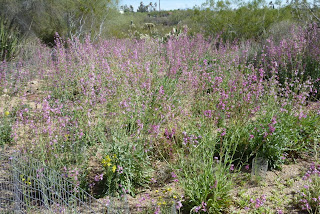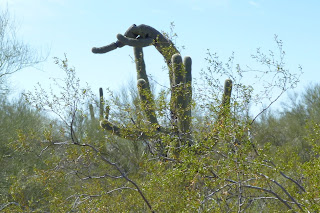This park has been named by National Geographic Traveler as one of the top 22 "secret" gardens in the US and Canada. It began in 1966 when the Wilsons began to piece together parcels of land that became the core of the park, in the end totally 37 acres. Two houses were in the park, one now the tea house and gift shop. In the 1970s a # of developers tried to get them to sell for commercial building, but they refused.
The park itself was formally dedicated in 1985 to create something natural and beautiful in the NE part of Tucson. 12 acres were later added, so that the park now totals 49 acres.
There are actually 5 season in the area, and the park has an area to highlight each one. There are "dry" gardens, some that are watered, a saguaro cactus trail, etc. There is also a wall depicting the geological development of the area, the Santa Catalina mountains.
I loved the vibrant orange shade of this flower.
Lots of shades of purple!

And then this little white flowr in the midst of this greenery.
Unusual flower on tree in parking lot
Blackfoot daisy
Cacti were starting to set fruit. Others had interesting shapes/characteristics.
Prickly pear cactus with fruit and thorns
Hedgehog cactus with purple flower
There were lots of birds and ground animals in the park. There were 2 kinds of finches on this feeder.
Howard saw a number of birds including a cardinal. I also saw 2 rabbits, one large and one small.
Phainopepla
Woodpecker
Buckhorn cholla, normally green, but it times of drought or cold it becomes reddish or purplish.
Other items in the park including this 1550 lb blue rock
Throughout the park and also in the Tucson Botanical Gardens and the Arizona Sonora Desert Museum, works of the metal sculptor Kioko Mwitiki were on display and also for sale. Kioko uses rusty recyclable metals for her works of art. One amazing one was the horse below, which was surrounded by cacti.
See the horse behind the cacti
A vulture by metal artist Kioko
There is a special section with saguaro cacti and how they fit with the native culture. Saguaro take 65 years before they begin to grow extra limbs.



This one has at least seventeen limbs so much be well over 100 years old.
This tall one seems to be pointing!
The saguaro probably appeared in the Tucson area about 8000 years ago. It has accordion like pleats which allow it to stretch and absorb more water when it is available and contract as it uses the water. Most of the roots are just below the surface and can spread out more than the cactus is tall to get water that is shallow too. It can weigh 6 to 8 tons and 90% of that weight can be water.
Tucson is close to the northernmost area for the saguaro to grow. The area rarely has frosts, but in February it had a hard frost and many saguaro were damaged. Whenever they are in an area where it is below freezing for 20 hours, the cacti can die.
These are the second tallest cacti in the world. However, they greow quite slowly. After a year they may just be 1/4 inch tall and after 15 years just one foot tall.
The Tohono O'odham Indians in the Arizona area used the saguaro fruit for a variety of purposes. The syrup and pulp were made into jam and candy and used to sweeten bread. Each piece of fruit produces 2000+ seed, which the Indians added to porridge and ground into flour. They also were used to feed chickens.
Artist depiction of Tohono O'odham life
The Tohono months were somewhat based on the growing season of the saguaro fruit





































No comments:
Post a Comment